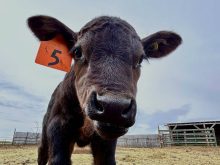Canadian imports up 27 percent | Analyst says BSE prompted search for new global markets
NASHVILLE, Tenn. — U.S. beef exports achieved record levels last year even though restrictions continue in some lucrative markets like Japan and the European Union.
The U.S. sold 2.83 billion pounds of beef valued at $4.7 billion to more than 130 countries.
Exports were up 23 percent last year and expected to increase another 11 percent this year.
BSE restrictions dating back to 2003 may actually have forced the Americans to scan the globe and start doing business in places it had not tried before like Russia, the Middle East and smaller Asian countries, said Brett Stuart, research analyst for Cattlefax.
Read Also

Canadian Food Inspection Agency extends chronic wasting disease control program consultation deadline
Date extended for consultation period of changes to CWD program
“One of the things that BSE did was prompted us to develop those other markets by necessity,” he said during market sessions at the National Cattlemen’s Beef Association annual meeting in Nashville, Tenn., Feb. 1-4.
In total, the U.S. exported 15 billion lb. of beef, pork and poultry, resulting in record prices paid to producers. If trade was blocked, the U.S. would struggle with the unexpected surplus.
“What would happen if we had to consume another 15 billion lb. in the domestic market? We wouldn’t be enjoying these prices,” said Kevin Good of Cattlefax.
Total world meat exports are 53 billion lb. or 24 million tonnes. The U.S. share of world trade is 28 percent. Brazil has 22 percent while Canada had seven percent of the business.
Canada and Mexico accepted record amounts of U.S. beef.
Exports to Canada at the end of November were 174,122 tonnes valued at $940 million, up 27 percent in volume and 43 percent in value. It was a record for volume and value and sets the stage for a $1 billion year-end total, reported the U.S. Meat Export Federation.
Mexico accepted 234,888 tonnes worth $902 million. A weaker peso slowed the export pace at the end of the year.
Canadian live cattle imports to the United States declined, with 76,164 Canadian feeders shipped last year, compared to 190,977 in 2010.
However, Mexico has endured drought for several years and exported 16 percent more feeders in 2011. About 1.4 million were placed in U.S. feedlots.
Japan continues to be the premium market and the United States is confident the age restriction on cattle will be raised to under 30 months from the current 21 months and younger requirement.
Traceability will remain important, said Dan Halstrom of the federation.
“Even if we go to 30 months, there is still a demand to know where that meat came from and how the meat was age verified,” he said.
If the age requirement changes, that could add $50 per head in value and would allow another 134 million lb. of American beef into Japan.
It could also sell more tongue, small intestine and tripe used in the barbecue restaurant sector. Currently, Australia is providing much of that. At 30 cents per lb., the United States is looking at a market of $47 million worth of intestines.
“Variety meats are worth a lot of money,” Halstrom said.
“Once we get back in with (under 30 months), this is probably the biggest value proposition we will see.”
Other access issues continue.
Taiwan does not want beef or pork containing residues from ractopamine, a beta agonist fed to cattle and pigs to promote lean muscle growth. It has detected 48 violations from eight different beef sources and 11 pork violations.
“Ractopamine issues have the potential to derail some of the success we have been seeing,” said Halstrom.
He estimates beef exports would have doubled if not for the residue issue. But global beef prices will rise again in 2012 while production has declined worldwide for five consecutive years.
“We have added 300 million people to the planet in the last five years and we have taken 3.4 million tonnes of beef out of circulation. When we started reducing production, prices got extremely volatile,” said Stuart.
“For 2012, we can expect more of the same.”
Brazil is one of the few nations expanding its cow herd but with improved disposable incomes, more is being eaten at home rather than exported to Europe, Russia and the Middle East. Its exports dropped by 10 percent.
Major growth has appeared in the halal trade to the Muslim world, a market Brazil once dominated. Saudi Arabia, Egypt and Jordan are buying offal products, ungraded and Select grades mostly for food service. They are accepting cattle of all ages.
The European Union set a 20,000 tonne non-tariff quota in 2009 for hormone-free beef.
In 2011, the U.S. shipped 13,257 tonnes and is now the third largest supplier behind Argentina and Brazil. The quota is due to expand to 48,000 tonnes by mid-year.
The primary exporters to the U.S. were Australia, New Zealand and Canada.















